Statistics > SOPHIA Milestone > Sophia Introduction to Statistics Milestone 1_ Score 90% (All)
Sophia Introduction to Statistics Milestone 1_ Score 90%
Document Content and Description Below
Cindy measured and recorded the temperature of a liquid for an experiment. She used a poorly calibrated thermometer and noted the temperature as 100.5 degrees Fahrenheit. The actual temperature of th... e liquid was 95 degrees Fahrenheit. The percent error in her calculation is . • 5.79% • 4.08% • -5.79% • -4.08% A trainer is studying the effects of vitamin D on his athletes. He has realized that there are many potential confounding factors, such as gender and age. To limit the effect of these confounding variables, he decided to first group two athletes together based on these variables (for example, two 21-year-old males). Then he randomly assigned one person to receive the vitamin D and the other to receive a sugar pill. What type of experimental design does this situation demonstrate? • Randomized Block Design • Simple Random Design • Completely Randomized Design • Matched-Pair Design Which of these statements best defines a stratified random sample? • It is a sample in which every element has the same chance of being selected from the total population. • It is a sample where the population is divided into roughly equal groups, and then elements are randomly selected from each group. • It is a sample where the population is first broken into groups and then elements are randomly selected, in proportion, from each group. Mike wants to find out the approximate income for professors in Michigan. He decides to randomly select 50 professors who work for a college or university in Michigan and obtain their salaries. What are the sample and the population of Mike's study? • The 50 professors that Mike interviews are his sample, and all of the professors who work in Michigan are the population. • The 50 professors that Mike interviews are his sample, and the professors that Mike does not interview are the population. • The professors in Michigan are the sample, and all the professors in the United States are the population. • Jenae's study ignored the fact that only some of her coffee choices had caffeine, even though her co-workers preferred caffeinated coffee. Therefore, Jenae decided to label one type of decaffeinated coffee as having caffeine to see what would happen. As she anticipated, this coffee became more popular with her co-workers, and they claimed that the extra boost of caffeine helped them focus on their work. The growing popularity of the decaffeinated coffee among co-workers, under the false impression that it gave them extra caffeine, is an example of . • a case-control study • a treatment group • a control group • the placebo effect A factory manufactures bolts. One of its employees, working in the quality control department, checks the first 20 bolts manufactured in a day for possible defects. This is what type of sampling? • Stratified sampling • Voluntary response sampling • Systematic sampling • Convenience sampling The following shows the Consumer Price Index (CPI) for the years 2000-2005. All of the values use a reference year of 1983. Which of the following is true about the CPI, based on the information? $100 in 1983 would be equivalent to $172.40 in 2000. • $100 in 2005 would be equivalent to $194.50 in 1983. • $100 in 2001 Would have been worth 189.70 in 1983. • $100 in 2000 would be equivalent to $183.70 in 2003. A scientist is conducting a study on the effect of eating chocolate and overall mood. They believe that gender is a significant factor. The participants are divided by gender. Then, within each group, participants are randomly assigned to consume either chocolate or a placebo and then rate their mood for the day. This experiment will run for two weeks. Which type of experimental design does this situation describe? • Case-Control Design • Matched-Pair Design • Randomized Block Design • Completely Randomized Design A student group on a college campus wanted to create a survey about parking availability on campus. The student group randomly selected 300 students to take the survey. One of the questions read, “Many students believe the lack of available parking is a major problem. Do you agree or disagree?” Of the 300 students that took the survey, 285 surveys were returned. This survey will most likely suffer from which of the following types of bias? • There is no bias in the way this survey is carried out. • Response bias • Non-response bias • Selection bias A researcher would like to determine which age groups (18-29, 30-49, 50-64, 65 or older) in the United States currently identify playing golf as their favorite pastime. Which statistical study would be most appropriate to answer this question? A census • A prospective observational study • A single-blind experiment • A survey A different coffee seller offered to sell coffee to Jenae's company for half the cost of their current brand. Jenae knew her co-workers were really partial to the coffee they drank now, so she decided to conduct a study to see if they noticed the difference in flavor. Her co-workers were convinced they would. Jenae provided each person with a sample and said that some had the new coffee and some did not. Only Jenae knew who had which brand of coffee. Jenae's strategy is an example of a(n) . • randomized experiment • blind experiment • matched-pair designed experiment • completely randomized experiment Ben is measuring the effect that the potential energy of an object has on the height of an object's bounce Which variable represents the height of an object's bounce? • Explanatory variable • Response variable • Confounding variable • Independent variable To test the effectiveness of a new, cholesterol-lowering drug, a group of researchers recruits 200 volunteers with high cholesterol to take part in a study. The researchers place the numbers 1 through 200 in a hat and have each participant select a number. Those who picked an odd number receive the new drug, while those who picked an even number receive a placebo. Which experimental design are the researchers using? • Randomized Block Design • Matched-Pair Design • Completely Randomized Design • Representative Sample Design A poll conducted a week before the school election to the student council showed that Janice would win with 63% of the vote. The margin of error was 14%. If Janice needs to receive at least half the votes to win the election, can we be confident of Janice's victory? • No, because she could receive as low as 14% of the vote. • Yes, because the poll stated that she will win with 63% of the vote. • No, because she could receive as low as 49% of the vote. • Yes, because she could receive as much as 77% of the vote. Jenae noticed that many of her co-workers would opt for the coffee that appeared to be most recently brewed, regardless of the flavor of the coffee offered. This leads her to believe that what she was witnessing was not really representative of everyone's true flavor preferences. She adapted her experimental study accordingly. Select one control in Jenae's experimental study. • Jenae keeps the same amount of sugar and artificial sweetener at each location. • Jenae takes note of the frequency in which co-workers refill their coffee mugs. • Jenae monitors the habits of the co-workers who do not drink coffee. • Jenae places condiments at random places throughout the kitchen. A research team conducts a survey to determine the area of land used for farming in Iowa. The team randomly selects house addresses and sends the survey by mail. Which type of sampling method is the research team using? • Multi-stage sampling • Cluster sampling • Simple random sampling • Systematic random sampling A retail brand plans to open its stores across all cities with a population of more than one million. To prepare for this, it refers to the past year's census done by the government. Which statement accurately describes the type of data the retail brand is using? The retail brand is relying on raw data because it has to ask for permission to use the census. • The retail brand is relying on available data because customers provide information to the census. • The census is an example of available data because the government provides it. • The census is an example of raw data because the government provides it. In 2007, 4% of people buying new cell phones purchased a bluetooth earpiece during the same transaction. In 2012, 28% of people buying new cell phones purchased a bluetooth earpiece during the same transaction. Of the following choices, what is correct about the growth of bluetooth sales? • It rose by 24 percentage points. • It rose by 120 percentage points. • It rose by 24%. • It rose by 12%. Of 400 randomly selected people in the city of Lyon, France, 60 people had the first name Hugo. Which of these does NOT represent inferential statistics? • 15% of the people who live in France have the first name Hugo. • 15% of the people who live in Europe have the first name Hugo. • 15% of the people who live in Lyon have the first name Hugo. • 15% of the people surveyed have the first name Hugo. Melissa is conducting a survey of her classmates because her teacher wants the class to learn more about hygiene habits. Melissa has developed a list of 10 questions. “Do you brush your teeth every day?” is the first question she asks. Which type of question is Melissa asking? • Open and binomial question • Open question • Closed question • Closed and binomial question In a game, Rachel throws three bean bags, aiming for the hole in the wooden board. Which of the following best classifies the arrangement of bean bags? • High accuracy and high precision In a study to assess the risk of obesity with the amount of time exercised per week, researchers matched each patient, in a sample of 500 people who are obese, with a person of the same ethnicity, gender, and age (along with other similar characteristics) who is not obese. The researchers asked the patients and their matches a series of questions, and then tracked eating and exercise habits regularly for several years. Which type of statistical study are the researchers conducting? • Case-control study • Prospective study • Retrospective study • Designed experiment The traffic volumes at a major intersection in New York were surveyed every day between one and four in the afternoon for a month to study the traffic patterns in the city. Which of the following types of bias affects the conclusions of the survey? • Non-response bias • Deliberate bias • Response bias • Selection bias Which of these random samples represents a representative sample of the number of students who enjoy science class? • 30 students who participated in the science fair • 30 students in the lunchroom • 30 students who failed science class last year • 30 students who received high grades in their science class last semester Which of the following data types will be continuous? • The letter grade Tyron received on an English test • The number of students who like chocolate or strawberry or vanilla ice-cream flavors • The amount of snow that fell last night • The number of books in the school library In a survey of small business owners, a response to which of the following questions would be qualitative? • How long have you owned a business? • How many businesses do you own? • What type of business do you own? • How much did your business have in profits last year? Rob sent an email survey to 2,000 cell phone owners asking about their satisfaction with their current plan. Only 256 people returned the survey and they were predominately 18-24 years old. Which of the following statements is true? • Rob is ignoring the assumption that all survey participants will want to act independently. • The survey suffers from census issues because only 256 people responded. • The survey likely has bias because the people who could not answer differ from those who did answer. • Rob included too many people on the survey list, affecting the data collected. The blood bank at a hospital has 1,200 units of blood, out of which 37% units are of blood group B+. A clinical researcher randomly selects 300 units of blood and finds that 33% of those are of blood group B+. To test his result, he randomly selects 200 units of blood and finds that 40% of those are of blood group B+. Which of the following is the reason there is a difference between the two percentages selected by the researcher? • The sample sizes were both too small. • The samples were not random samples. • Both samples suffered from non-response bias. • Random error; the numbers were different due to variability inherent in sampling. Select the correct statement regarding experiments. • A researcher cannot control the environment but can observe the response. • A researcher can control the environment and observe the response. • A researcher can control the environment but cannot observe the response. • A researcher can neither control the environment nor observe the response. . [Show More]
Last updated: 8 months ago
Preview 1 out of 21 pages
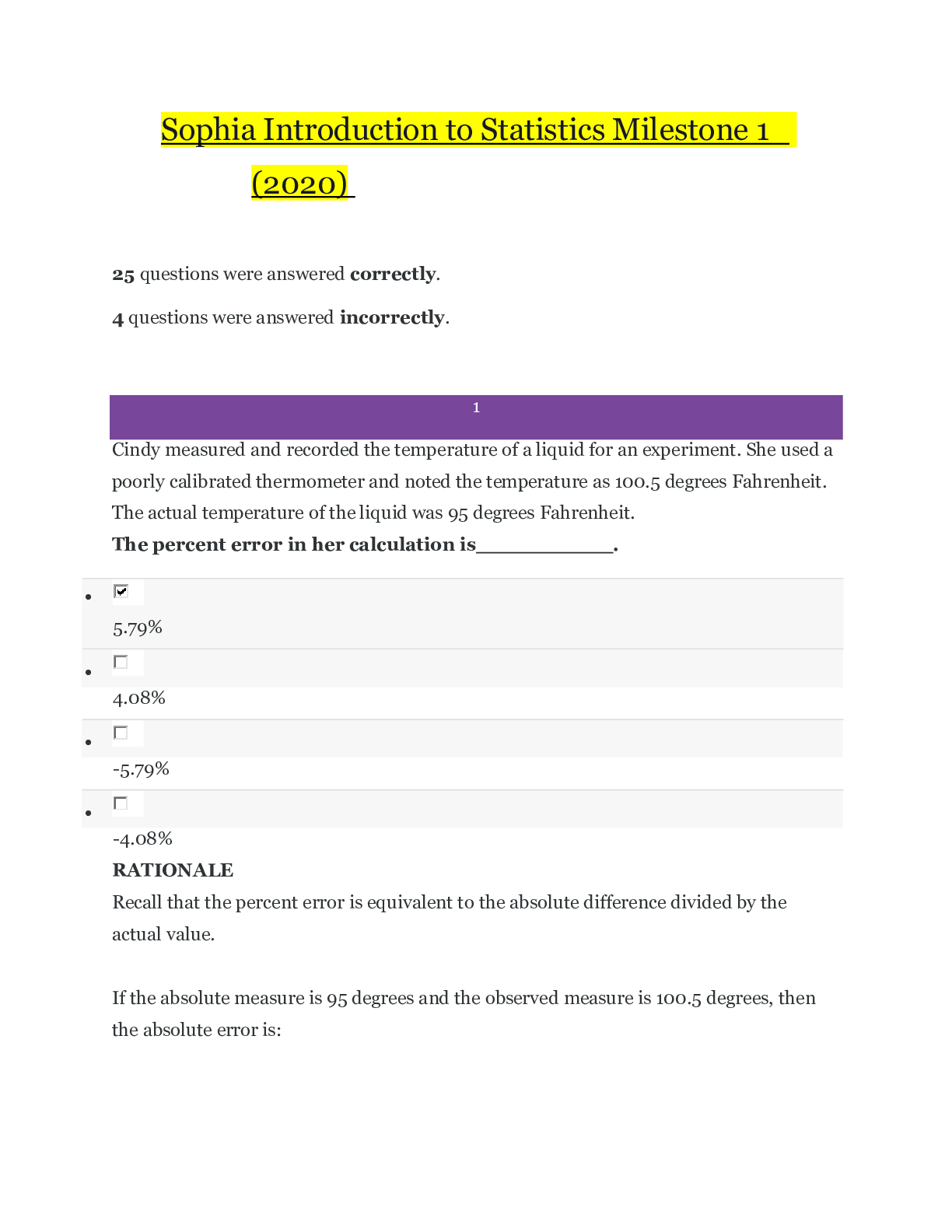
Reviews( 1 )

by kellyc79 · 3 years ago
Document information
Connected school, study & course
About the document
Uploaded On
Oct 11, 2020
Number of pages
21
Written in
Additional information
This document has been written for:
Uploaded
Oct 11, 2020
Downloads
2
Views
289

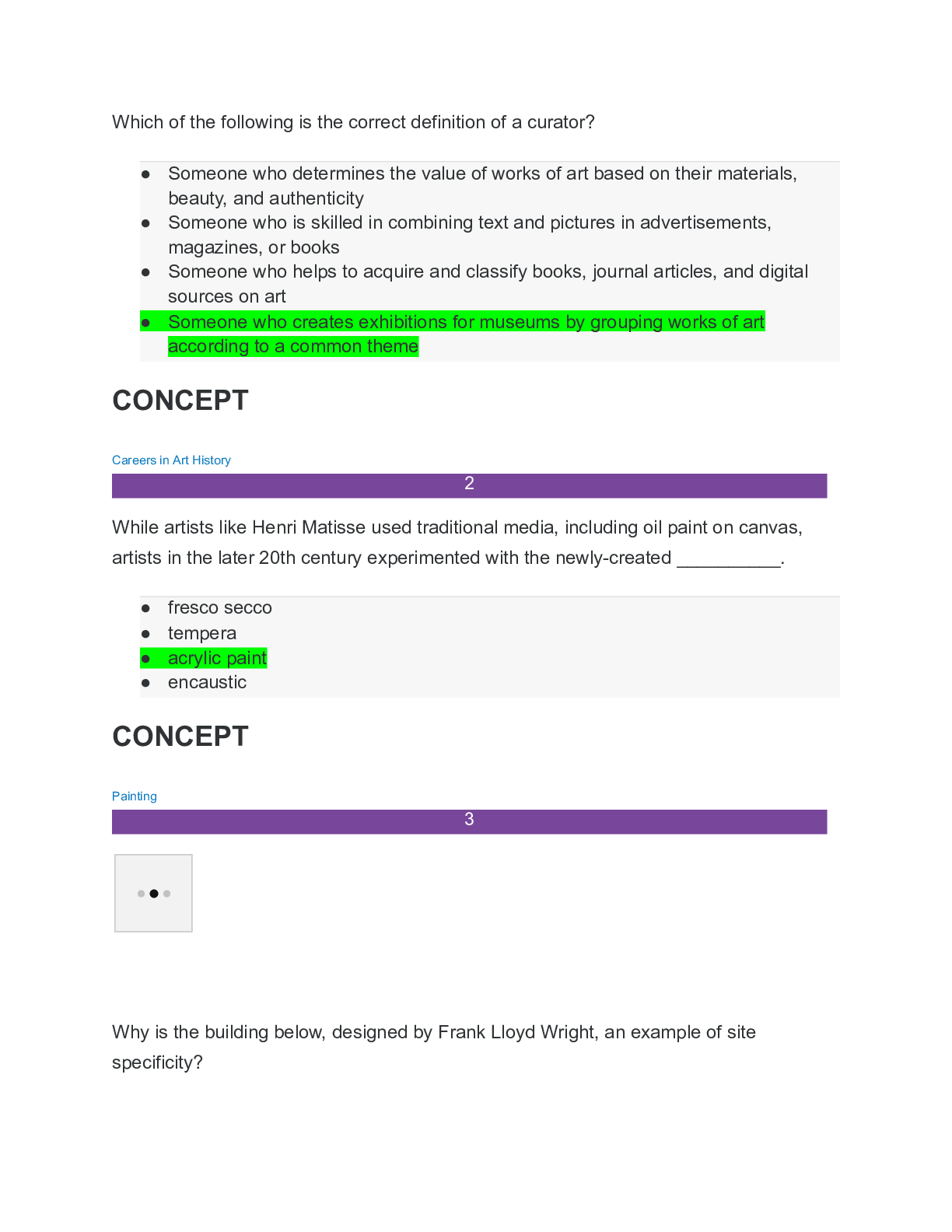
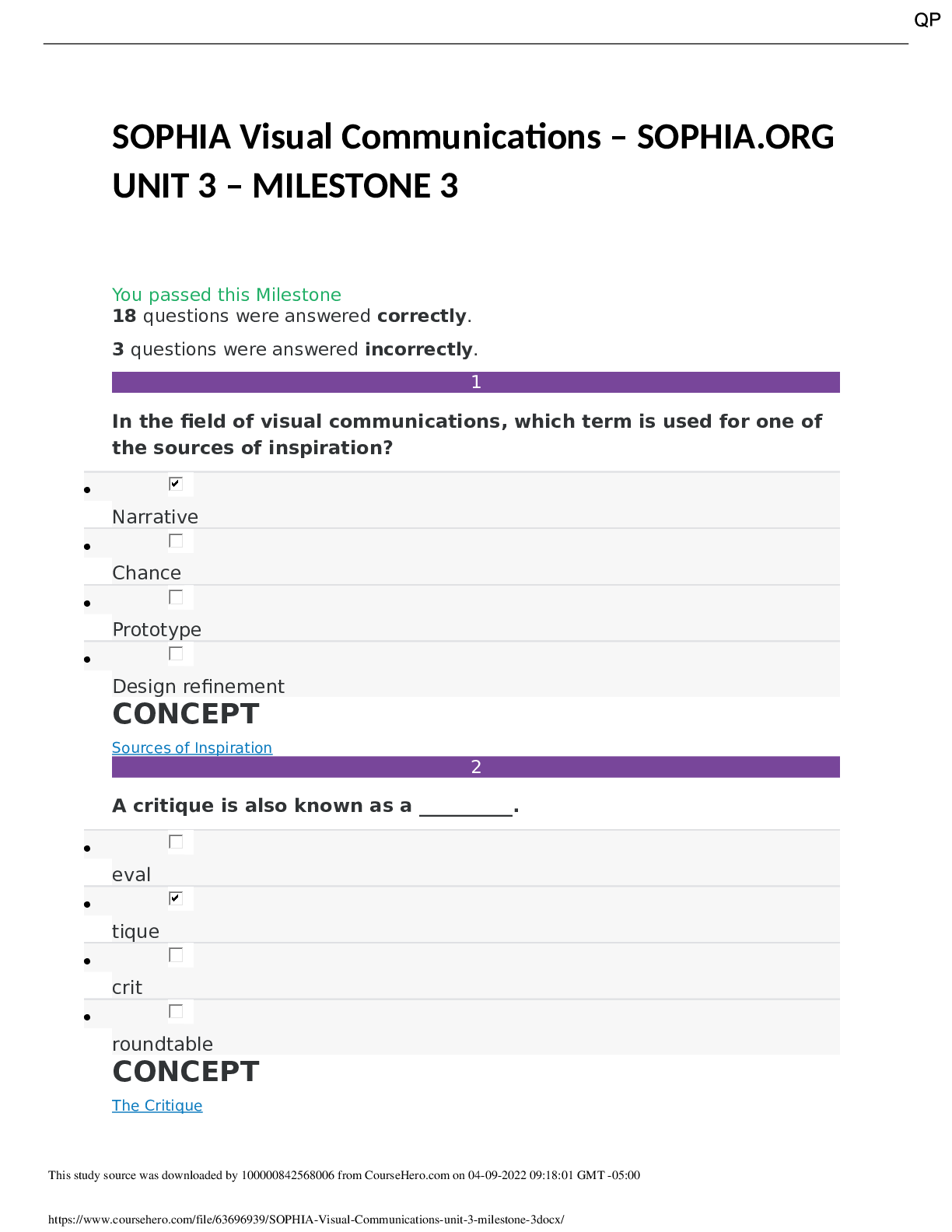
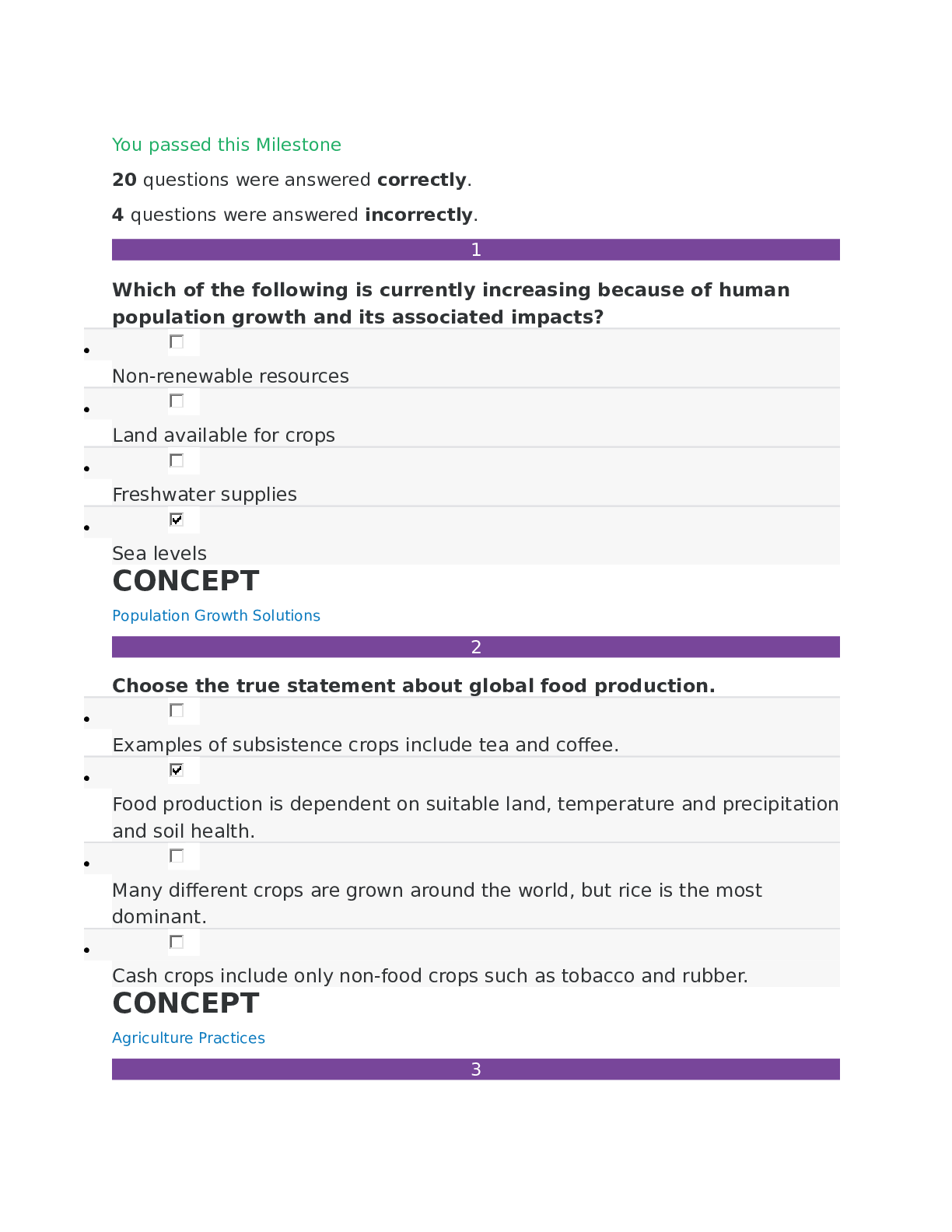

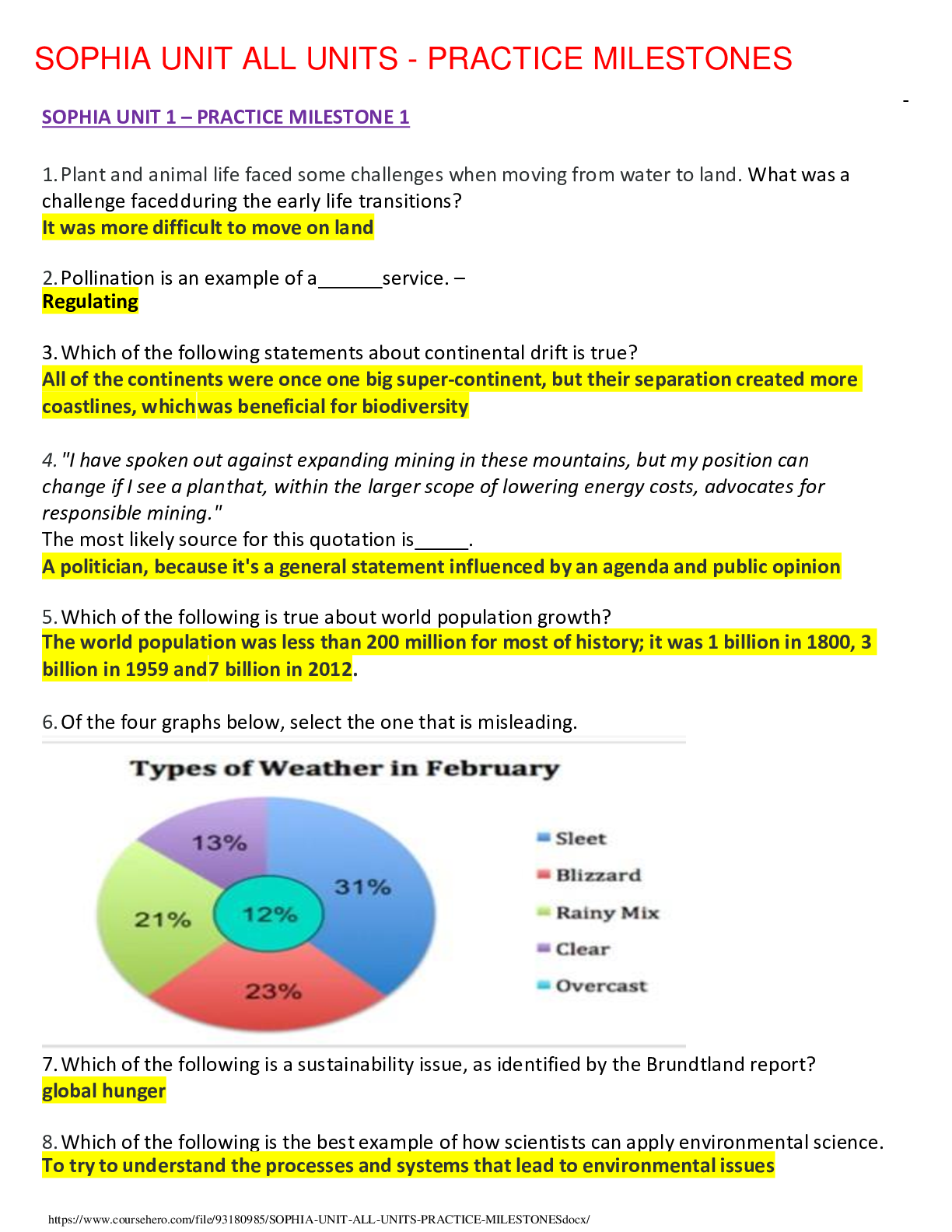

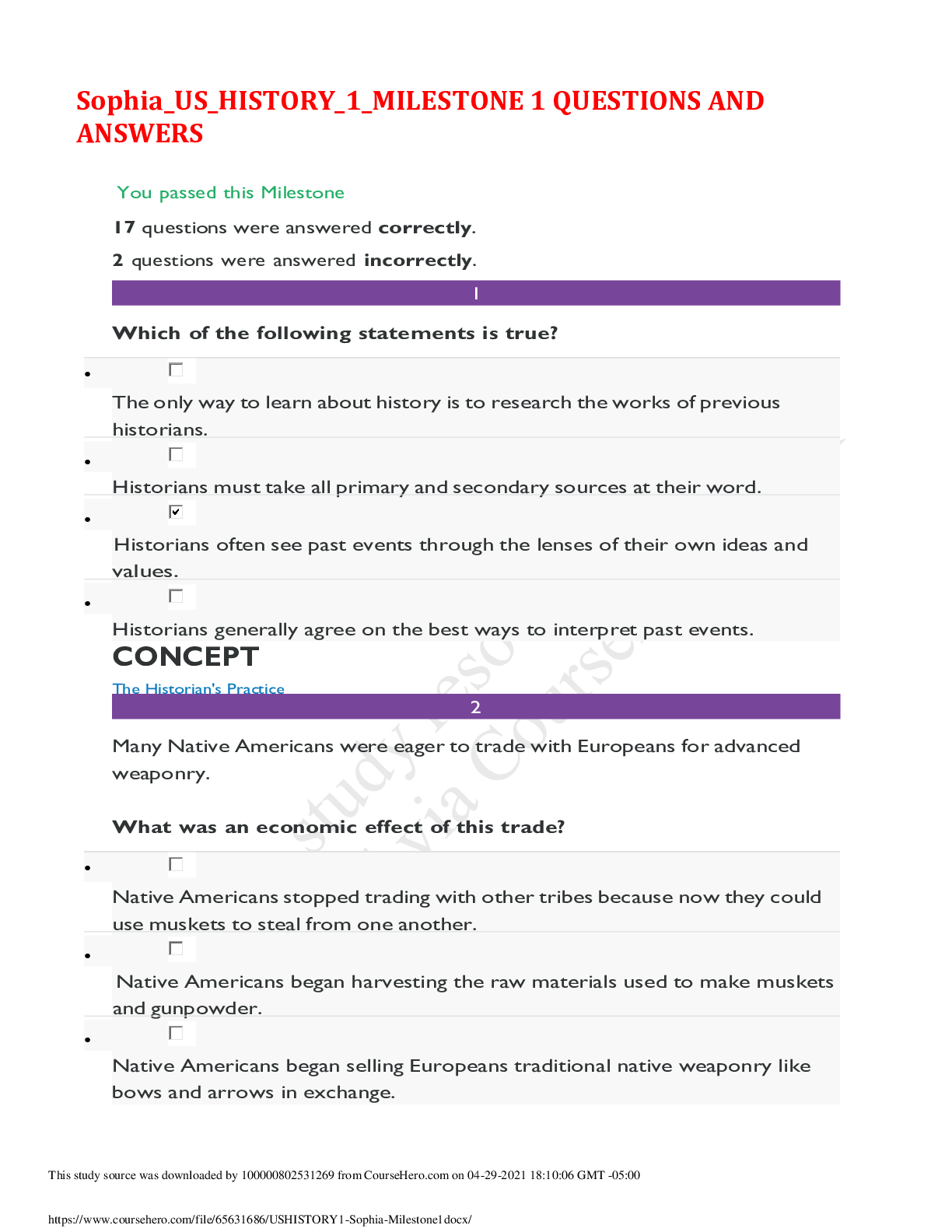
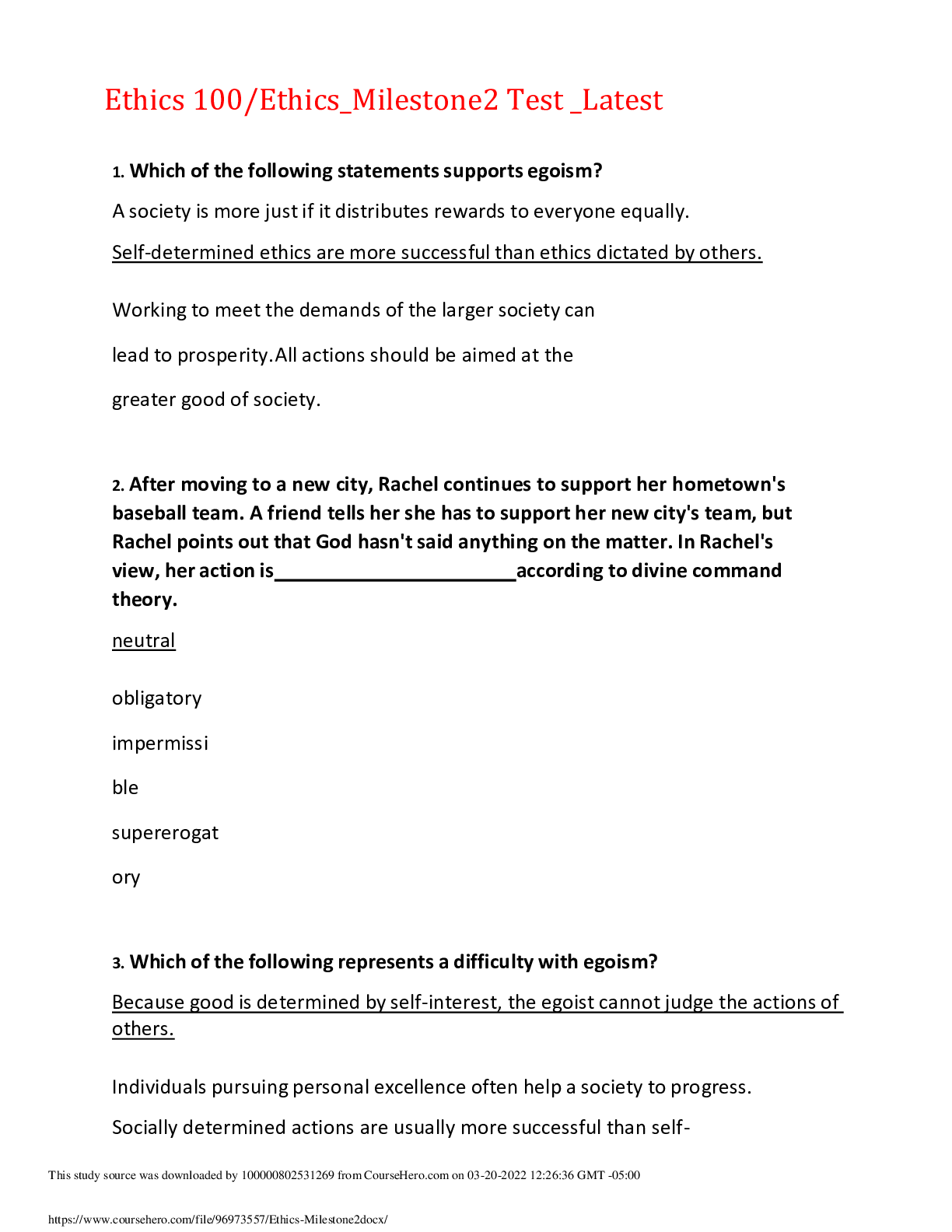
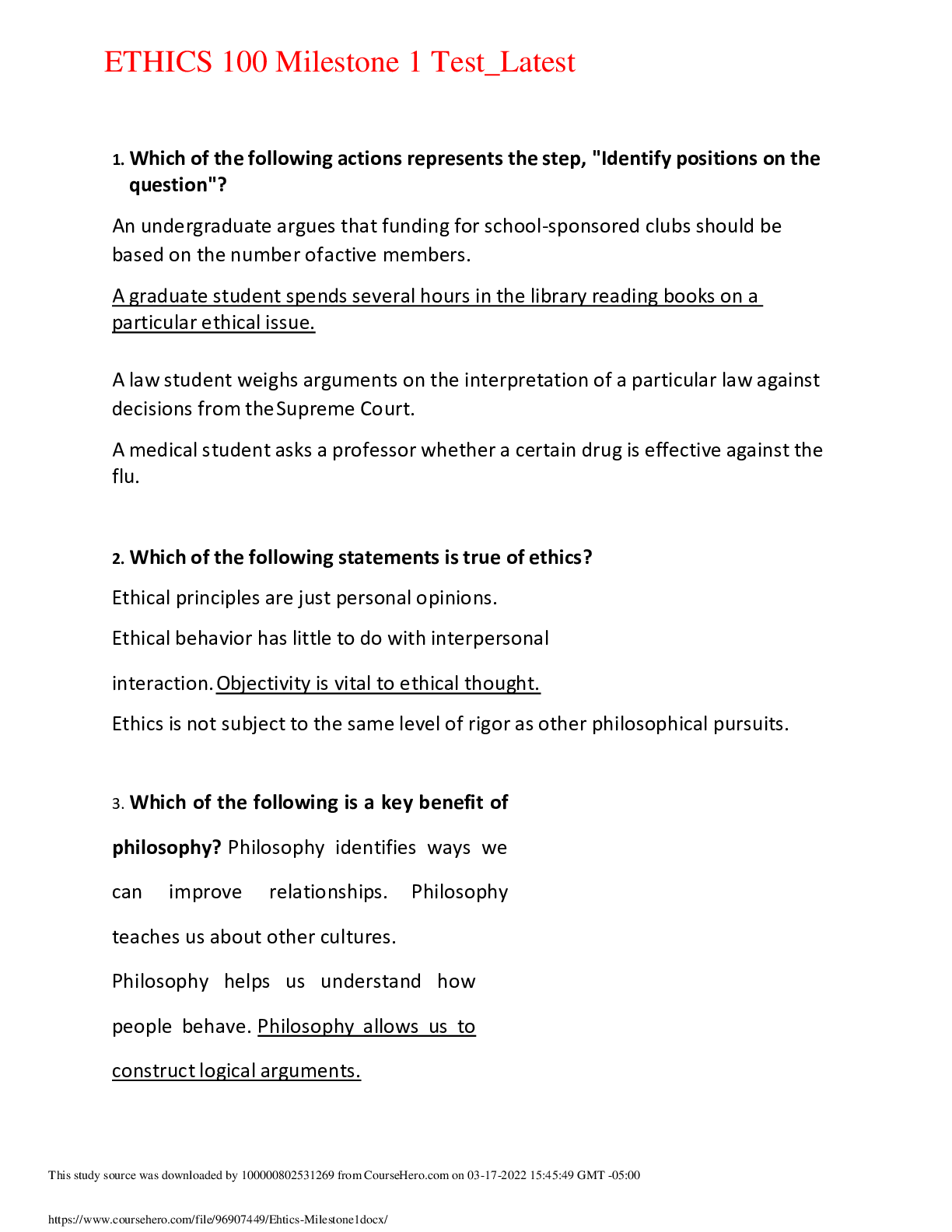


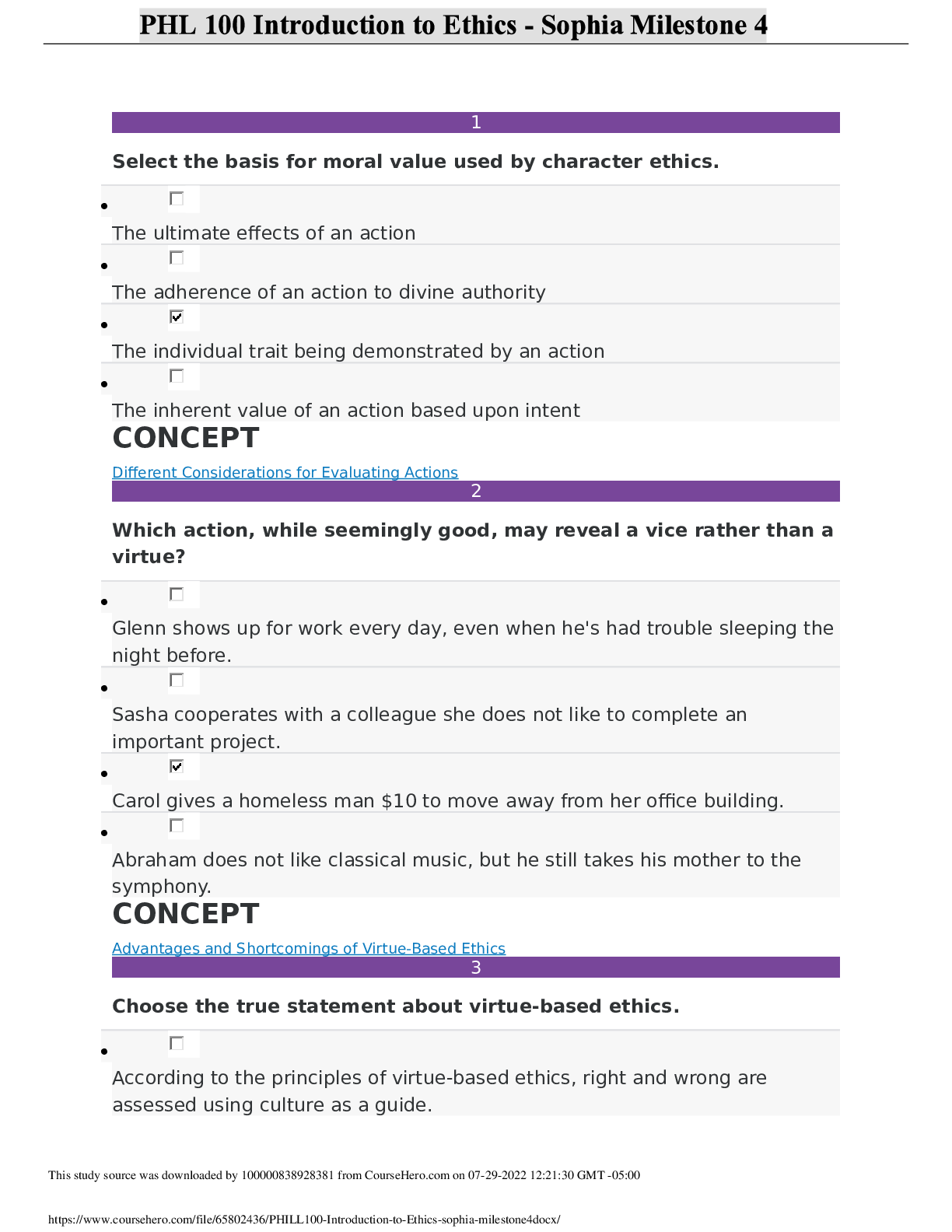
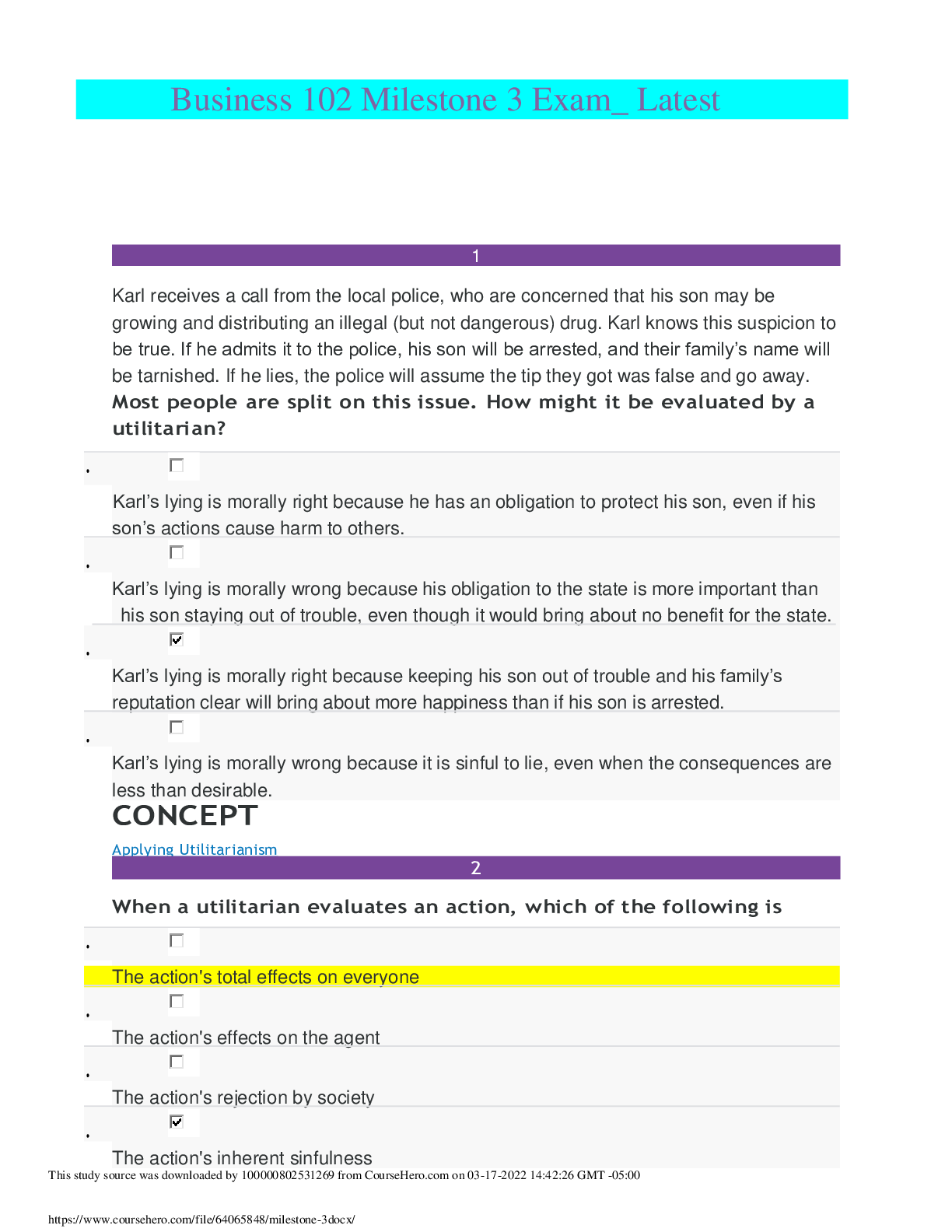


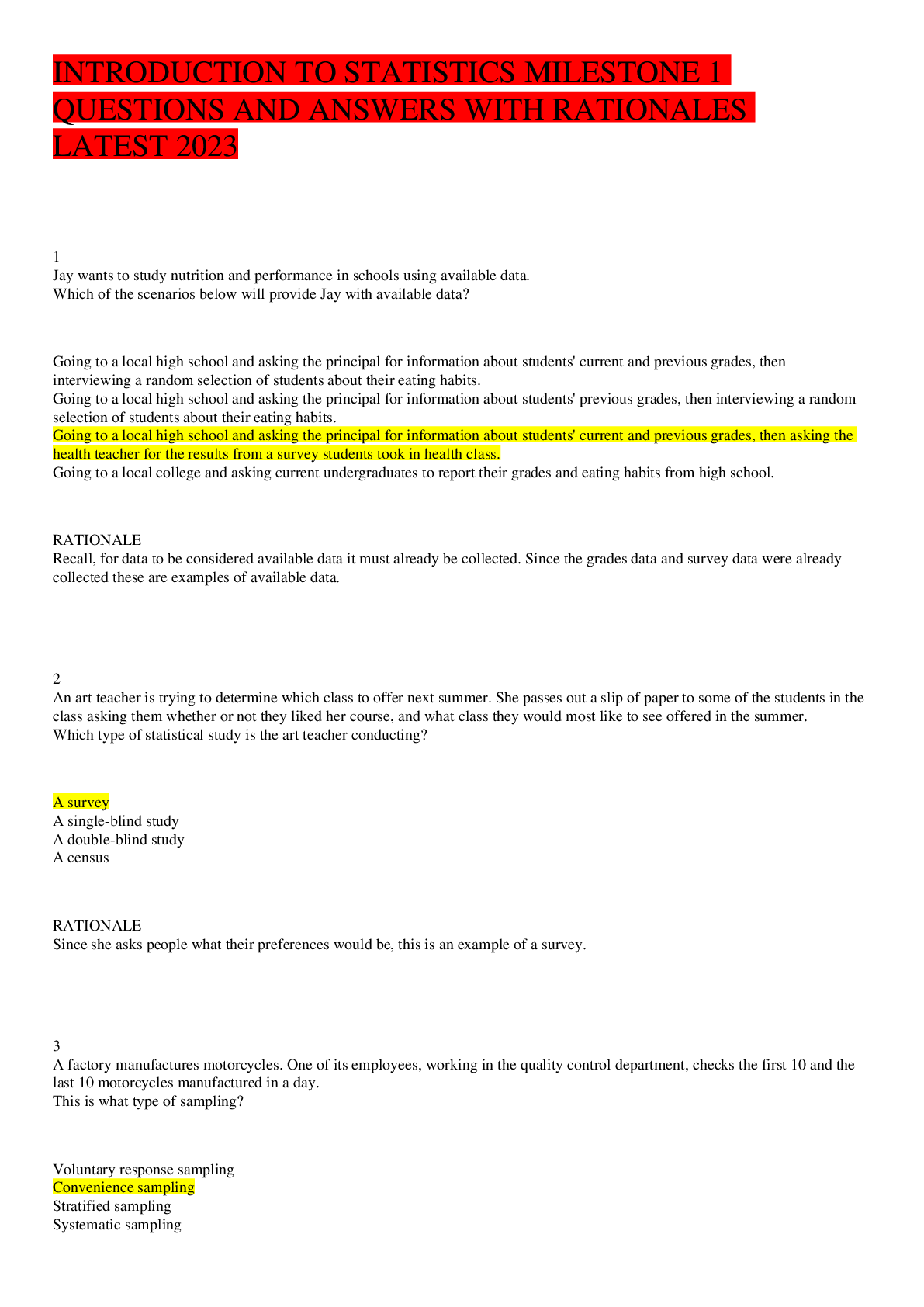

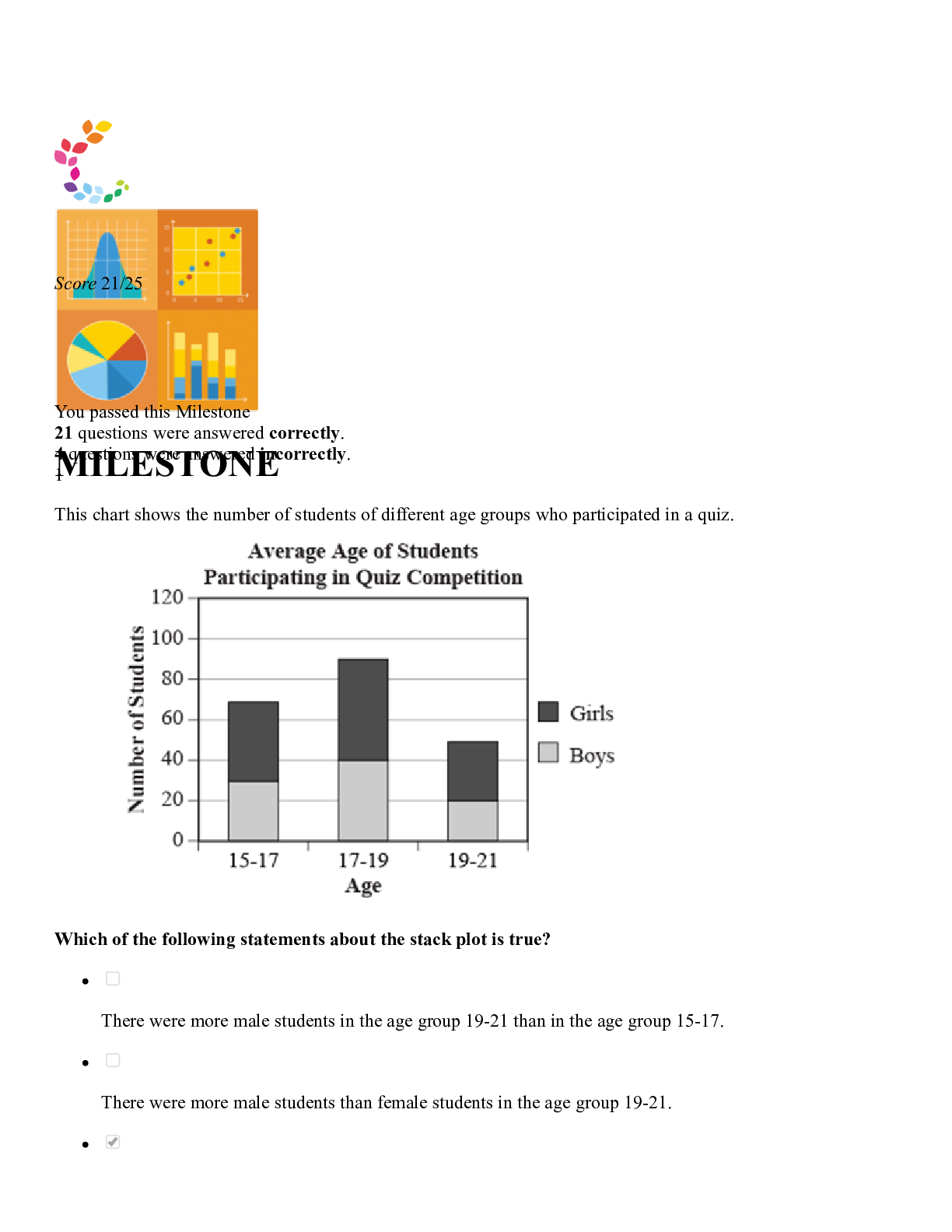
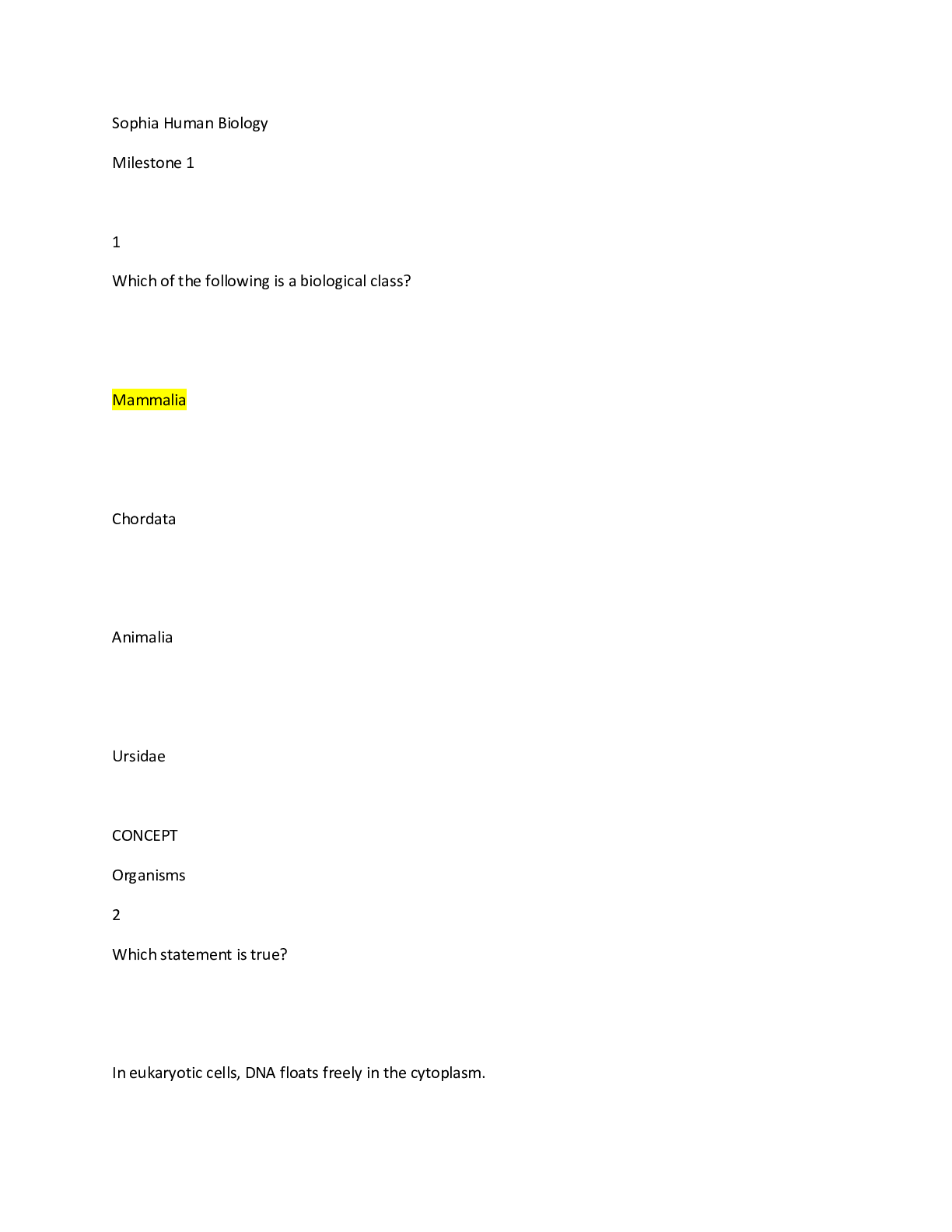
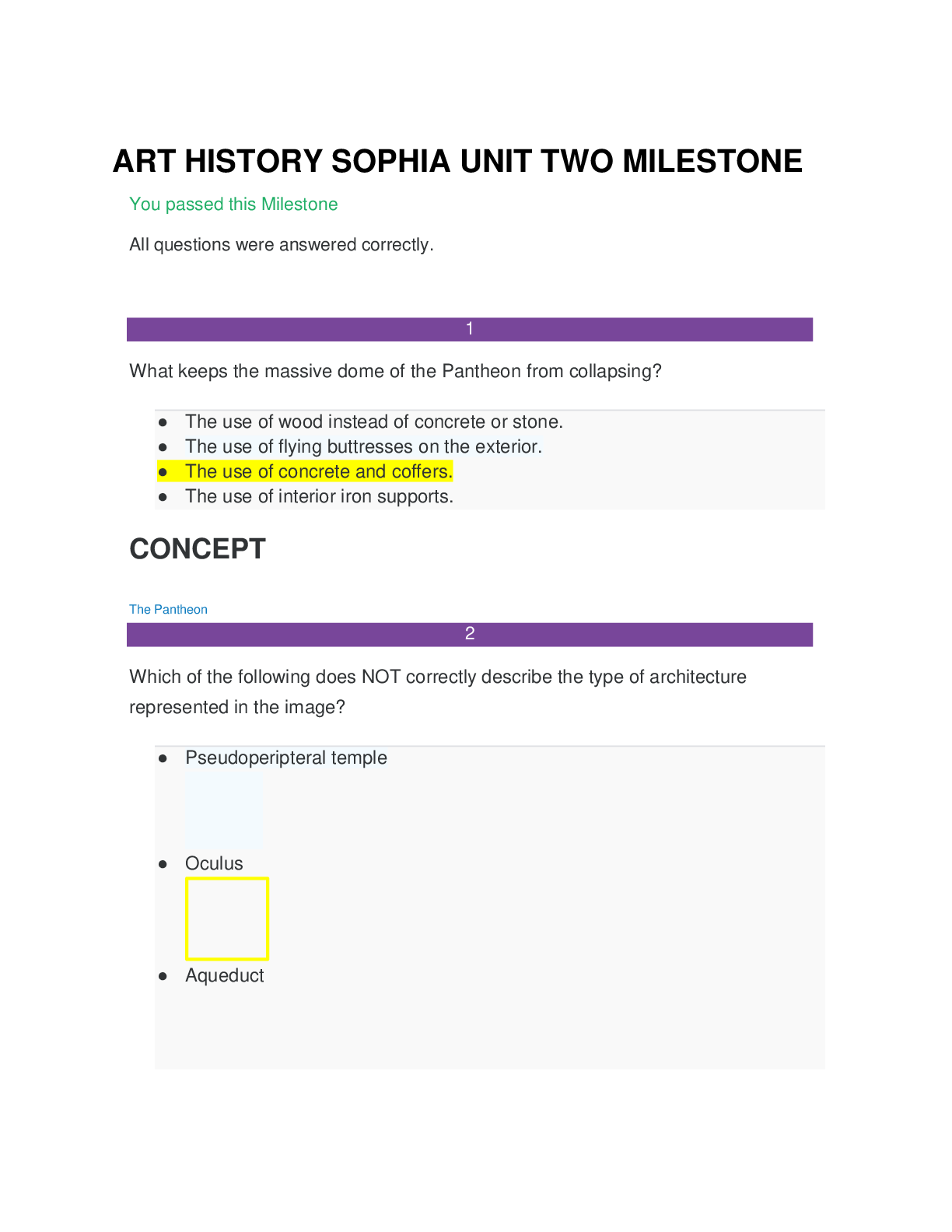
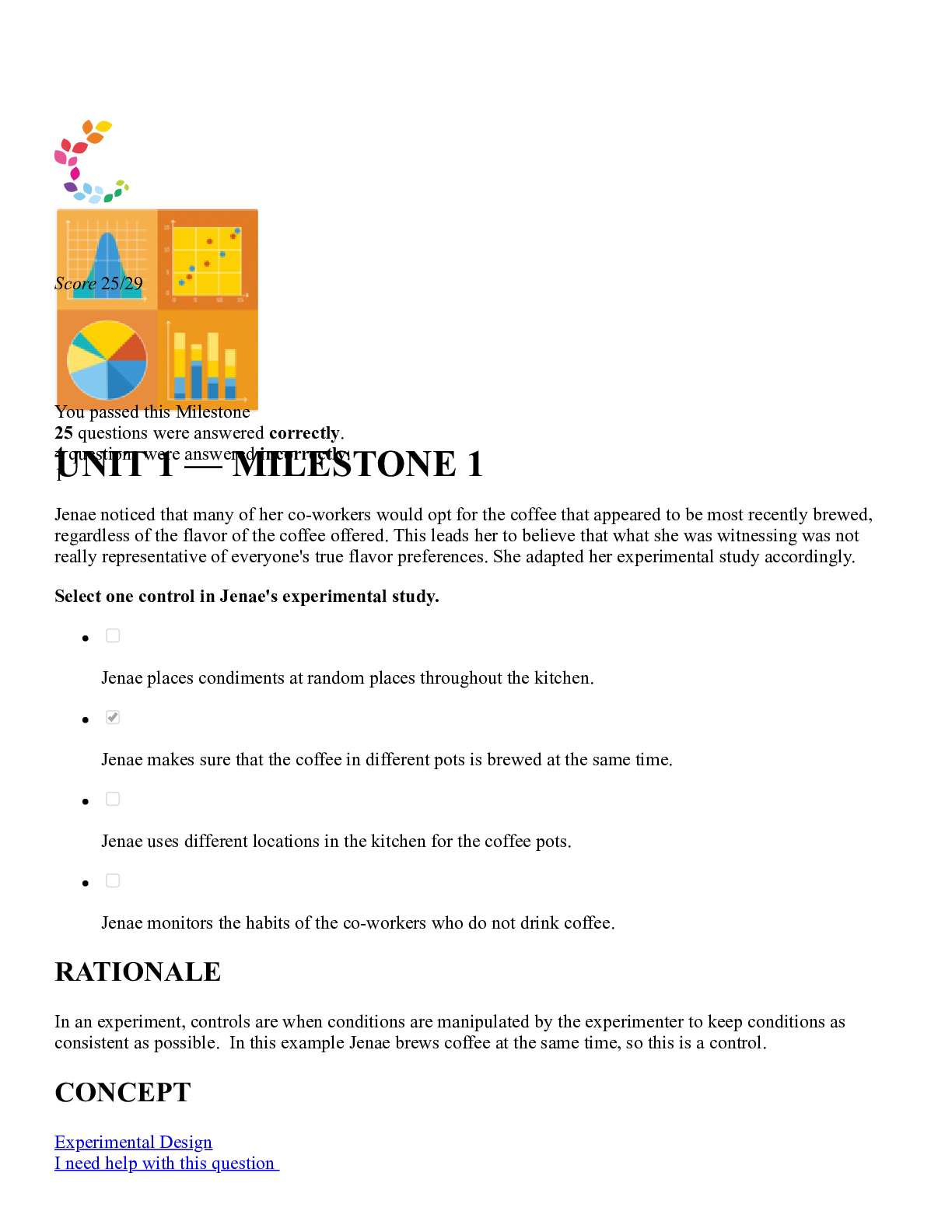

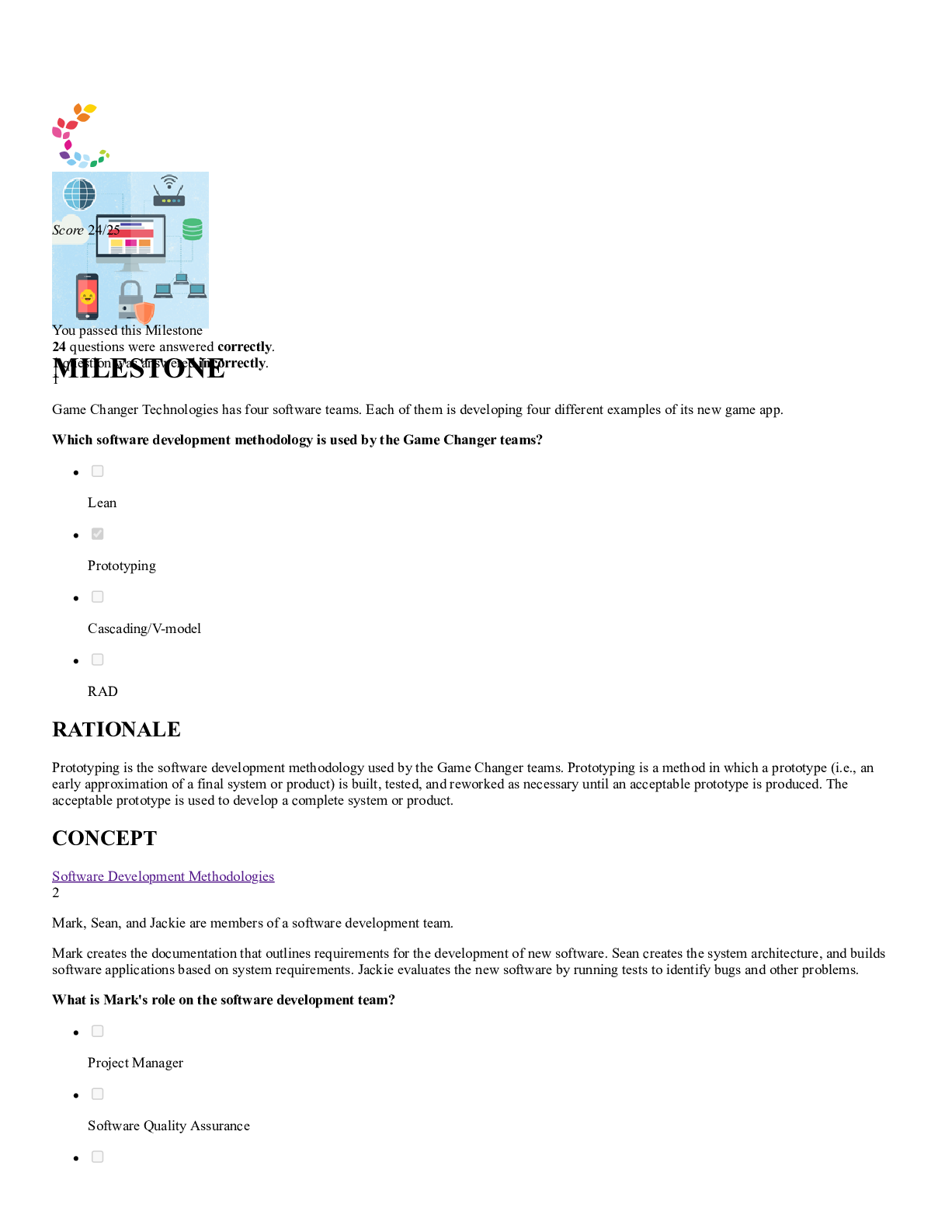


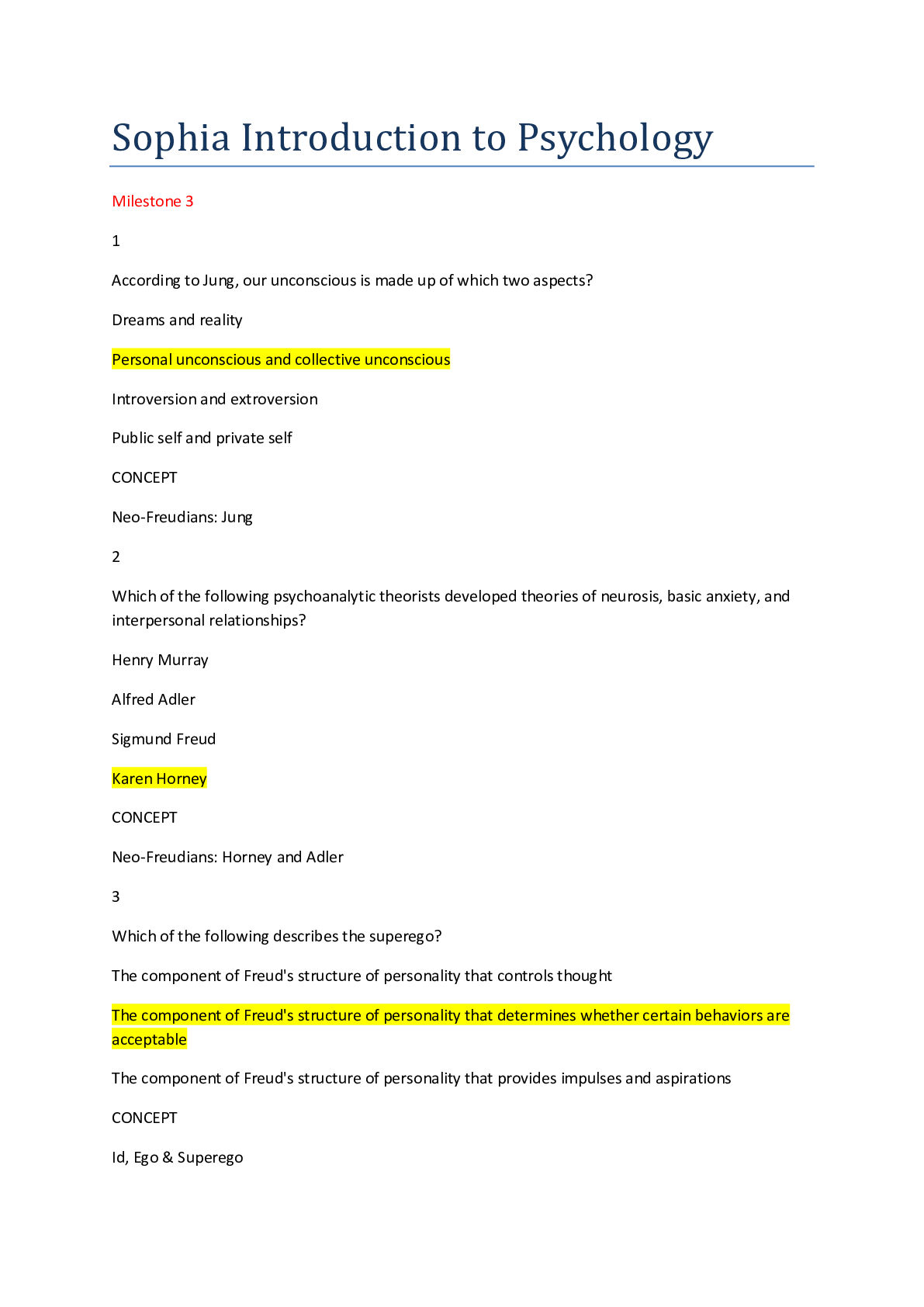


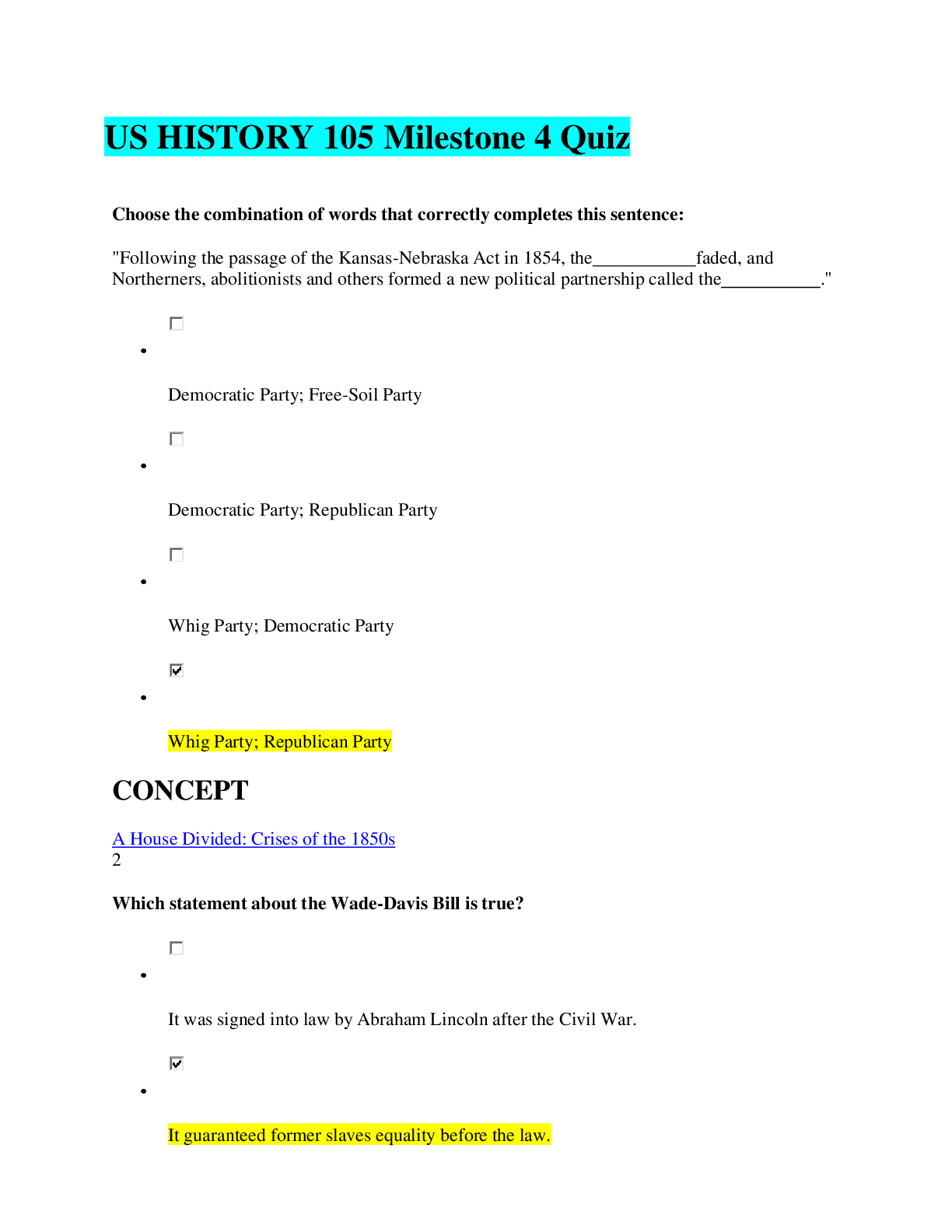
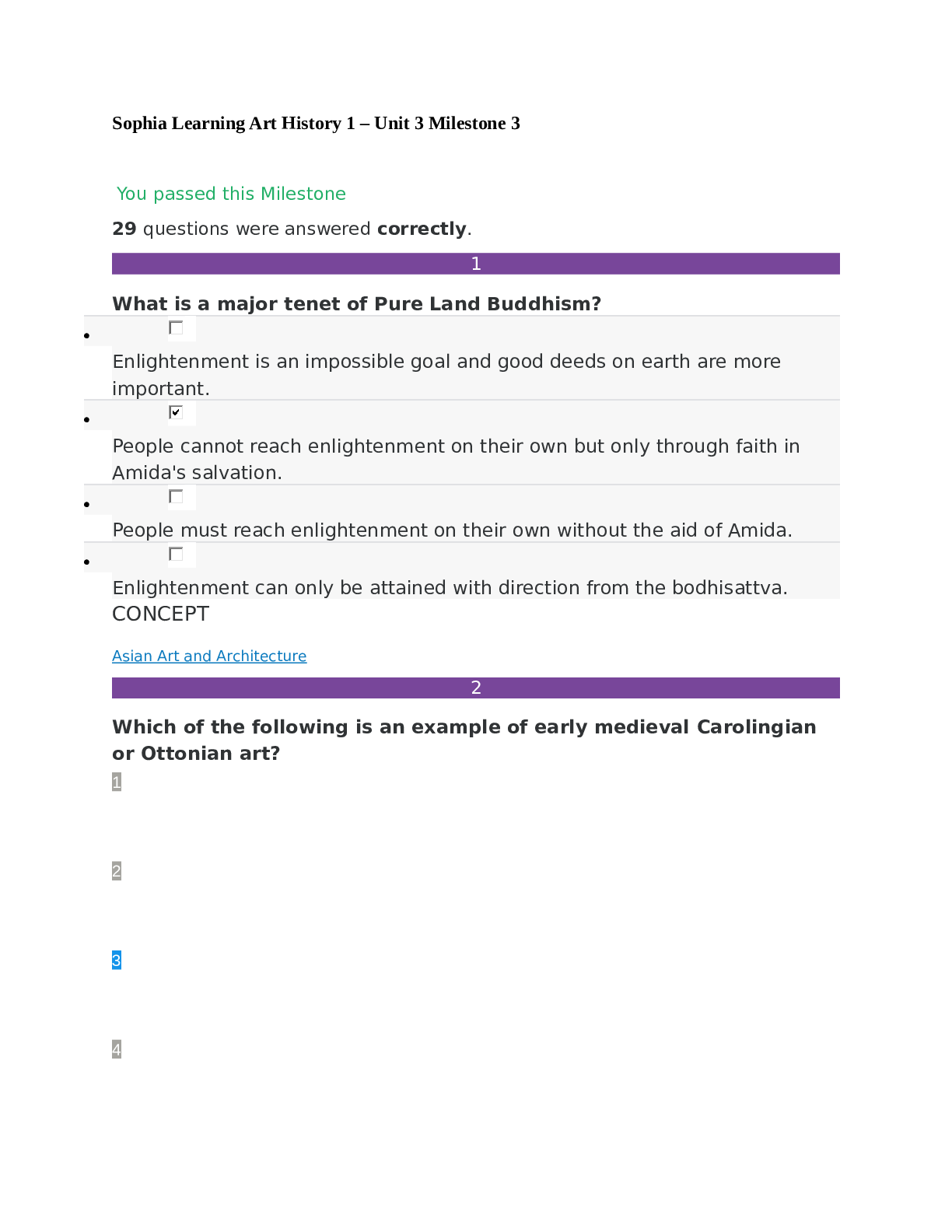

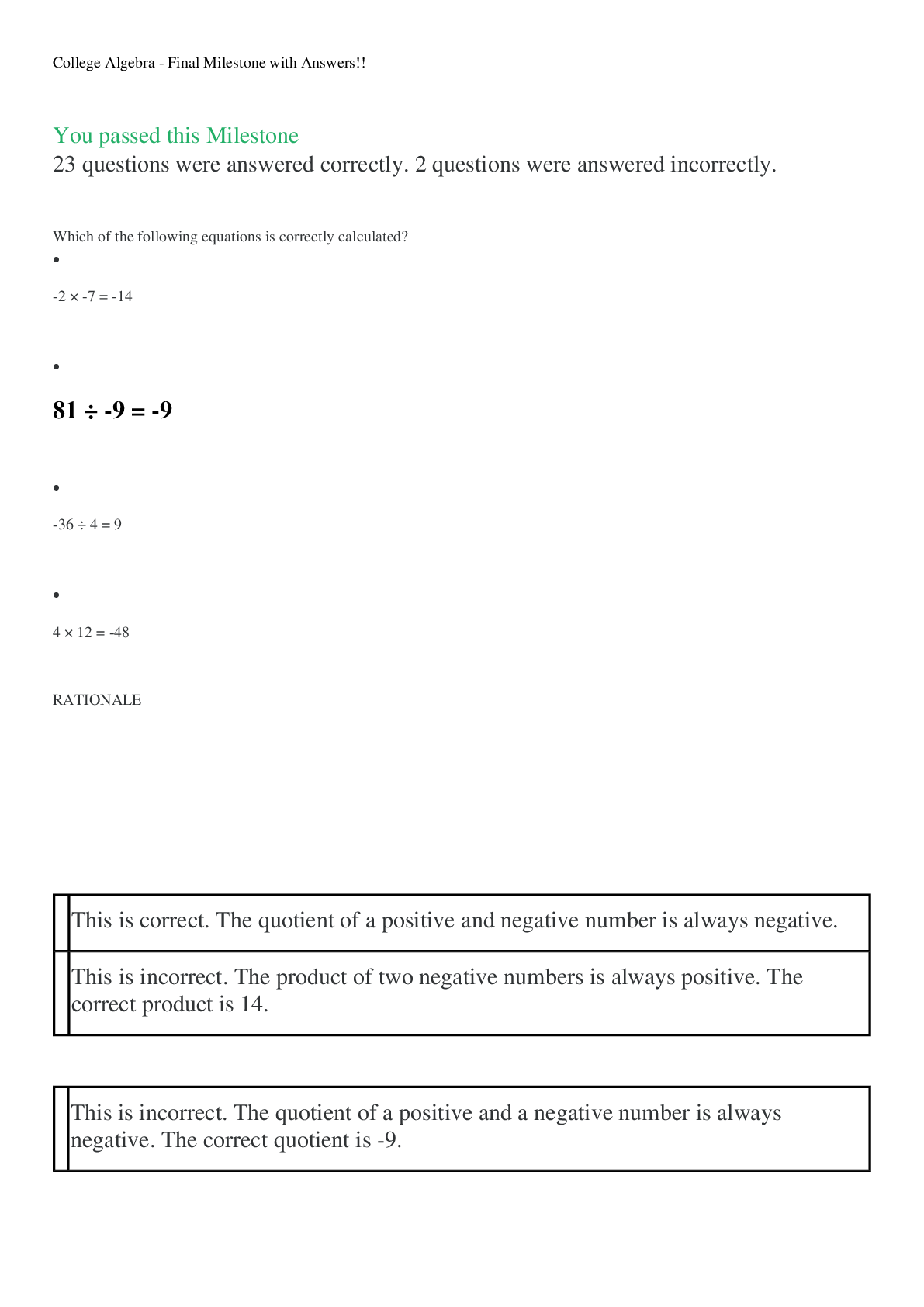
_removed.png)

